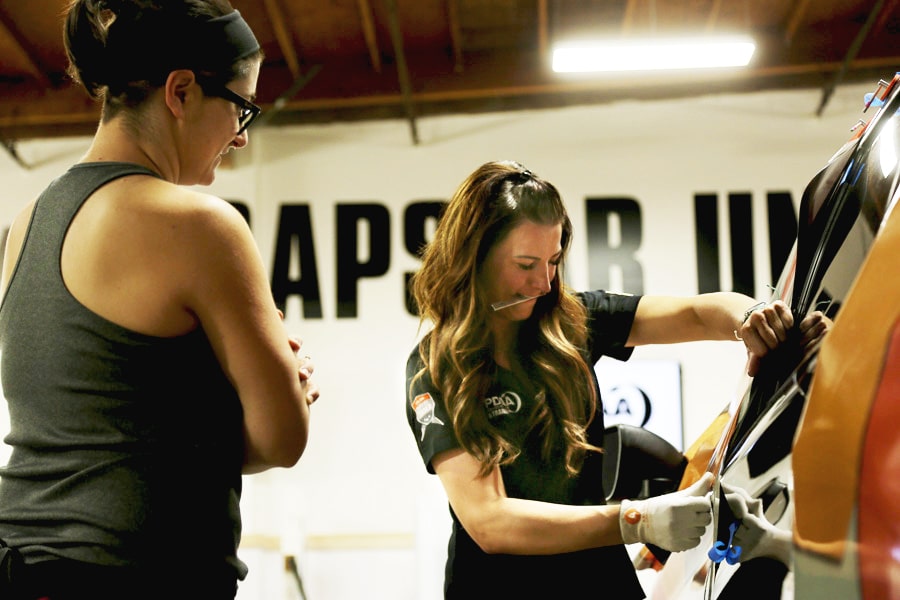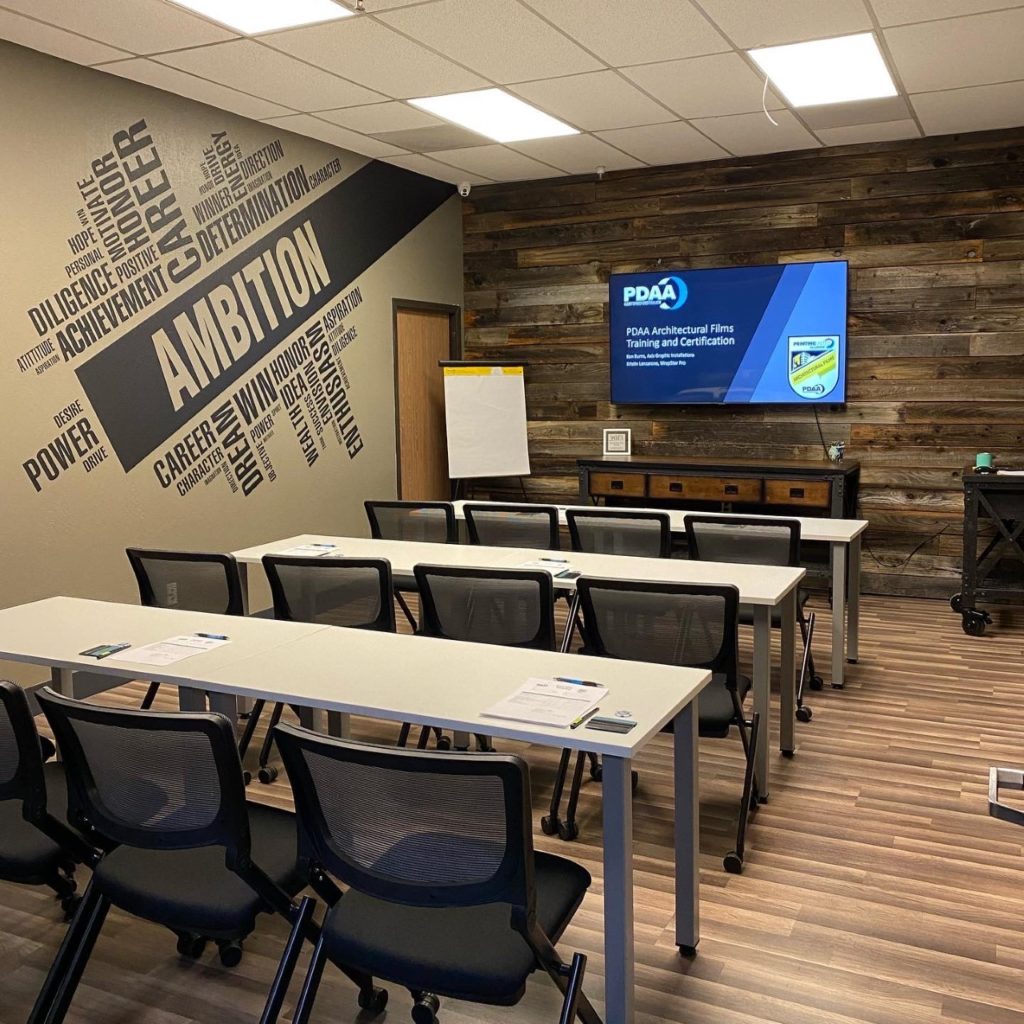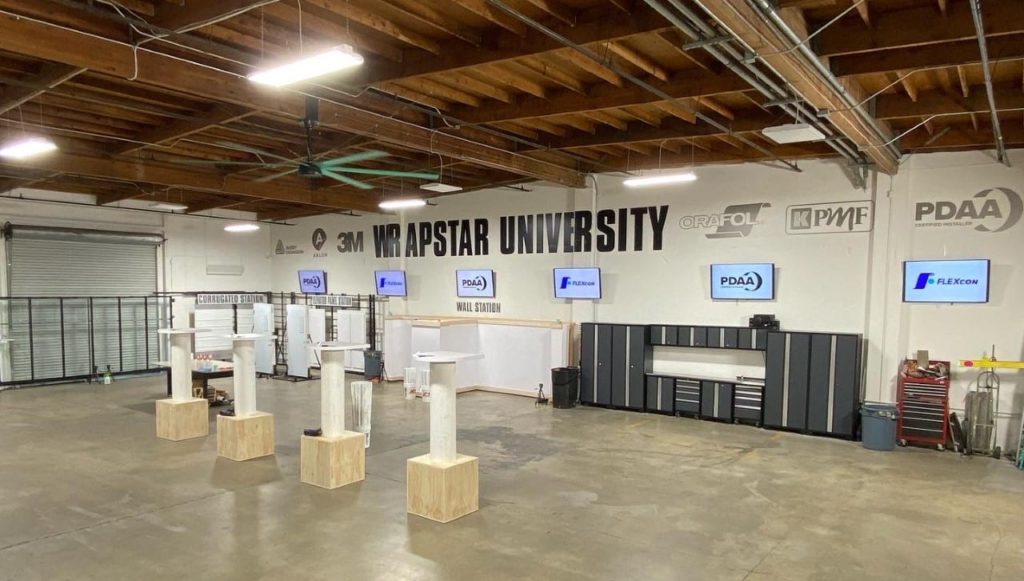WrapStar Pro Owner (Sacramento, CA) and Operator Kristin Lanzarone-Scribner is on a mission to help both advanced and up-and-coming installers thrive. Her newly launched universal training facility, WrapStar University, offers a place where installers can receive certifications and hands-on experience — and one that can serve all organizations, brands, manufacturers and reps.
Here’s the full interview with Kristin (KLS below), whose “New School” serves as the basis for our most recent Prints and Wraps column (see ST August 2022, page 42).
ST: Hands-on training for people who want to break into the industry is difficult to come by. Why did you decide to start WrapStar University? And why is a facility specializing in pressure-sensitive adhesives particularly important?
KLS: As a business owner in the wide format print and installation business, it’s a daily struggle finding installers and good quality ones without bad habits. For me, I love to help people and help them thrive. This is how I decided I need to help the industry by forming a training facility that can not only train and certify advanced installers, but be a place for new, upcoming installers in our industry.
[The goal is to bring] awareness to the beginners as well as into other forms of education like high schools, junior colleges and other trade schools. By no means do I want to compete with the top brands and organizations. That is not my purpose. If anything, my grassroots trainings will bring them their future customers. This is why I’m not associated with one brand or manufacturer, etc. This is a universal training facility that can house education and certification for all organizations, brands, manufacturers and reps.

Kristin Lanzarone-Scribner giving a vehicle wrap demo during one of the university’s recent programs.
ST: How large is the facility and how many students can it accommodate at once?
KLS: WrapStar University is shared among my current wide format print and installation company, WrapStar Pro. The unit overall is 6,700 sq. ft.; 3,500 sq. ft. of it is all shop space. The shop is where we do all of the hands-on training [for] windows, walls and floors; vehicle fleet; and resurfacing architectural films. The space will eventually adopt future training programs such as color-change wraps, PPF (paint protection films), ceramic coating, tinting and more. We have a classroom in the front part of the facility for in-class literature and video demonstrations. Depending on how many trainers are present, we can have 16-plus students for advanced installers and up to 10 for beginner-to-intermediate installers. We also offer special one-on-one trainings for beginner installers.
ST: I read your [LinkedIn] post saying this has been a five-year-long dream of yours, and it’s clear building the facility was a huge undertaking. What has been the most challenging part of this endeavor and how did you get through it?
KLS: It has been a five-year-long dream. It was more about location — [finding a] facility to house all the training stations while still being able to operate my normal business, [and] lastly, getting recognized within the industry to have the brand support.
I was completely self taught till I went to my first certification with Professional Decal Applicators Alliance (PDAA) in March 2018. […Then] in 2019 I joined the PDAA committee. I came in at the most critical part of the new restructure of the PDAA certifications. Since then, I have helped the group redesign the certifications and hopped on board to be a trainer for all three badges. This allowed me to gain momentum within the industry to be recognized as a trainer for pressure-sensitive adhesives.
I relocated my business in August 2021 and searched for a year to find a space that was functional to accommodate my future plans. I had hopes that during COVID spaces would be easier to find, but it was actually a lot harder for the [square footage] and functionality I needed, which added a lot of stress to my plate.
With that being said, the biggest challenges I faced were finding the facility and building each station. I built the majority of my stations and hired some qualified friends and family to assist in building those I couldn’t do, like the HPL wall stations with inside-outside corners, as well as the window stations. During this process, I kept telling myself to trust the timing. Be patient and it will all fall into place as it should at the right time.
ST: How long did the project take to plan and execute overall?
KLS: I moved into my space in August 2021 and it took me till January of this year to build out the space to be appealing, comforting and inviting for clients, students and my employees. This consisted of laying laminate wood floors throughout the whole office areas, knocking out a wall for my print production room, painting, adding my wainscotting touches through the common areas, adding lots of LED high-bay lighting in the shop, display monitors for each install bay, extra heat gun outlets (I have it designed so that I can have 16 heat guns run all at the same time without blowing any circuits), and HVAC in the shop space.
Building of the actual university took about a month and a half. [It consists] of two standard rivet panels and two corrugated rivet panels that look and mimic a box truck with the same top and bottom trim panels; a brick wall station wide enough to test two students at the same time; four HPL wall stations with inside-outside corners; two window stations of three window panes each; four round columns; four elevator panels with handrails; two-man door stations; four half-round tabletops; four 90-degree tabletops; and eight cabinet door fronts. The only thing that was ordered was a smart locker station.

The classroom area at WrapStar University.
ST: Please tell me more about the universal training facility’s target student. Is it intended for any new West Coast installer in need of certifications, is it designed specifically for future WrapStar Pro employees, or both?
KLS: WrapStar U is a universal training facility to host any brand, organization or distributor training/certifications. With the intention of building this space, we agreed to be the West Coast facility for Printing United PDAA. In the works is becoming a 3M certified training facility. Currently, I am a trainer for PDAA, Arlon and ORAFOL, and am currently going through the process of being a certified 3M trainer. My goal is to be a multi-brand trainer and one of the first to do so.
In 2023, I will launch the grassroots level training program for those who want to get into the industry as installers, but can’t afford to travel to get specialized training. With this grassroots level training, I will educate the 101s of commercial fleet wraps. From there, when the student attends the training and performs well on their certification, they then will be able to work for any wrap shop as an entry-level installer. This will help bring awareness to this trade and fill the void in our industry for the shortage of installers.
Once the grassroots level training kicks off, I will be focusing on bringing it into the local high schools, junior colleges and trade schools, as well as providing internships through WrapStar Pro. My employees will have the luxury of using the training stations for practicing and gaining extra experience whenever they want. Same goes for participating in any of the trainings I offer.
ST: How can someone sign up for the program if interested?
KLS: Currently, I’m building the WrapStar U website to showcase what we’re all about, the programs we will be putting on, a calendar of trainings and registration — which will be wrapstaruniversity.com. For now, students can sign up for PDAA trainings/certifications through printing.org.
ST: Can other shops send their teams to WrapStar University, as well?
Absolutely! It is common that a team of students will come from another wrap shop together, and sometimes the owners, too. I love this because it creates a relationship bond between competitors that I feel is important to have within this industry. There is plenty of work to go around for all of us and we don’t need to be closed off to one another. You never know, you may need assistance from another shop if your printer goes down or there’s a shortage of installers, etc.
ST: What types of specific training programs do you plan to offer? How are you catering to installers at the grassroots level?
KLS: Types of training programs I plan to offer will be:
- Grassroots level training and certification for every day commercial fleet challenges (launching in 2023)
- Grassroots level training and certification for architectural retail environments — windows, walls and floors (launching in 2023)
- PDAA’s architectural — windows, walls and floors; vehicle fleet; and architectural resurfacing
- Arlon’s advanced certification for vehicle fleet
- ORAFOL and KPMF vehicle fleet and color change
- 3M DI-NOC
- Fellers product one-day trainings
- Glantz product one-day trainings
Future programs:
- 3M vehicle fleet
- 3M windows, walls and floors
- Avery Certified Wrap Installer (CWI) trainings
- Grimco product one-day trainings
- Architectural product trainings for architects, designers and project managers
- Trade school, junior college and high school internship programs
ST: When it comes to your business in vehicle wraps, signs and banners, what is the most difficult technique to train employees on, and how does the new facility address it?
KLS: First is always quality and speed. Quality can be taught with the right mindset. Speed comes with experience. Breaking of bad habits is the worst. As for actual installation techniques, it varies from what the object is. For example, box truck rivets [and] using the RollePro; Sprinter van cut-in drops in the window channels; and vehicle wrap … objects like door handles and satellite domes. The training facility gives the luxury to my installers to continue to practice on the areas they lack.
ST: In a recent video post you showed various stations set up for windows, walls and floors. Are any of the stations permanent, or are they all meant to be swapped out for the next training/certification event?
KLS: The only thing permanent is the brick wall station and the standard rivet station. Everything else is movable. I have some stations on wheels to be easily moved around or to be moved out of the loading dock door should I need to use the dock. I have a rack wall that I designed with a fabricator to be my temporary stations. This allows me to add whatever station I need and replace it with something else.
For example, for Arlon’s vehicle fleet certification, they have a corrugated station. Arlon is the only manufacturer that [trains on] corrugated panels. So, I made that station to be removable for something else. Same goes for DI-NOC; they have elevator panels that pertain to just DI-NOC training. Some stations serve multiple purposes. For example, the walls and column stations work for PDAA’s Windows Walls & Floors and 3M DI-NOC.

Column stations set up in the shop space.
ST: What key materials, tools and equipment are the facility equipped with? Did any manufacturers make contributions to the facility?
KLS: I’ve outfitted the facility with some necessary tools. WELDY Heat Guns gave me a deep discount on purchasing multiple heat guns for trainings. MagStrapz donated heat gun magnet holders and magnets to the program. Grimco donated the last little remnants of colored wrap film to be used for training techniques. Auto Skins gave me a discount on their wall racks to hold all of the donated color films from Grimco and some vehicle wrap tools to use for demonstrations.
ST: What have you learned from the experience? Do you have any advice for other industry experts who want to start their own education programs? Is there anything you’d have done differently?
KLS: Starting a program the right way [requires] a lot financially, as well as credibility. If you don’t have the funding, don’t do it, if you don’t have the industry to back you — no one will show. It takes time to develop connections, networking as well as proving yourself as a whole.
I’m not in this to make a living, I’m in this to bring new quality installers into the industry. I preach to get all the trainings and certifications you can. Keep training and keep learning until you get it right. Never stop learning.
ST: What has been the most rewarding aspect of launching the facility? What are you most excited about now that it’s officially open?
KLS: Each morning walking in and seeing this space finally put together ready for trainings at any given time. The reactions all the students, brands and manufacturer reps have on their faces when they first walk through the door. The wows, the whoas and the excitement this space gives them … [it] brings a level of dedication as well as a level of comfortness while under the pressure of testing.
I am eager to train and certify the next wave of installers; however, their level of hard work and smiles at the end of testing is rewarding. If a student fails a station, I believe I failed them as a trainer. Those are areas I learn to better myself as a trainer for all levels of installers.
For more, read our August Prints & Wraps column featuring WrapStar University.
The post A Wrap Star Is Born appeared first on Signs of the Times.
Posted by: https://anaheimsigns.com
No comments:
Post a Comment